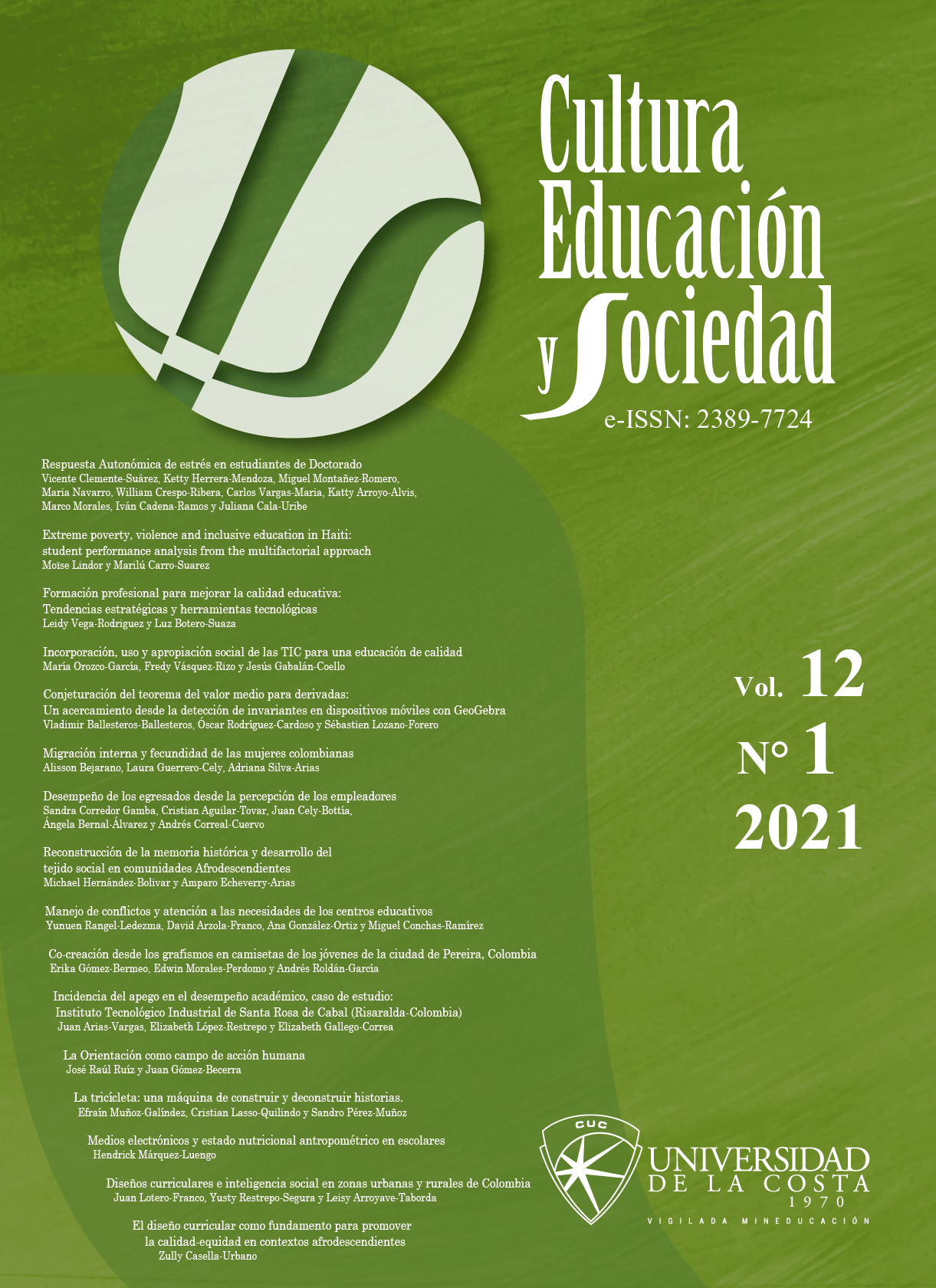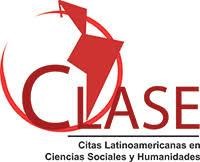Conjeturación del teorema del valor medio para derivadas: Un acercamiento desde la detección de invariantes en dispositivos móviles con GeoGebra
DOI:
https://doi.org/10.17981/cultedusoc.12.1.2021.05Palabras clave:
Aprendizaje móvil, Conjeturación, GeoGebra, Teorema del valor medio para derivadasResumen
Este artículo presenta los resultados de un proyecto de investigación cuyo objetivo fue describir el papel mediador de la aplicación móvil “Calculadora Gráfica” de GeoGebra sobre los procesos de conjeturación del teorema del valor medio para derivadas mediante la detección de invariantes a través de herramientas de arrastre, combinando geometría dinámica con cálculo infinitesimal. A través de un estudio de caso cualitativo, que involucró estudiantes de Ingeniería Aeronáutica, se dinamizaron los esfuerzos investigativos con el propósito de validar la hipótesis relacionada con una influencia positiva de una estrategia de aprendizaje móvil sobre el proceso de conjeturación en un curso de Cálculo Diferencial. Los resultados obtenidos permitieron evidenciar avances significativos en la conjeturación del teorema mencionado para la resolución de problemas en ingeniería y se discute cómo este tipo de recursos digitales, a través de un entorno de geometría dinámica en dispositivos móviles, puede servir como mediación para favorecer el aprendizaje del cálculo.
Descargas
Citas
Abu-Al-Aish, A., Love, S., Hunaiti, Z. & Al-masaeed, S. (2014). Toward mobile learning deployment in higher education. International Journal of Mobile Learning and Organisation (IJMLO), 7(3/4), 253–276. https://doi.org/10.1504/IJMLO.2013.057165.
Akour, H. (2011). Determinants of mobile learning acceptance: An empirical investigation in higher education. [Ph.D. Dissertation]. Oklahoma State University, Small city, USA. Available: https://www.proquest.com/docview/610058264
Al-Emran, M., Mezhuyev, V. & Kamaludin, A. (2018). Technology Acceptance Model in M-learning context: A systematic review. Computers & Education, 125, 389–412. https://doi.org/10.1016/j.compedu.2018.06.008
Baccaglini-Frank, A. (2019). Dragging, instrumented abduction and evidence, in processes of conjecture generation in a dynamic geometry environment. ZDM Mathematics Education, 51, 779–791. https://doi.org/10.1007/s11858-019-01046-8
Boero, P., Fenaroli, G. & Guala, E. (2018). Mathematical Argumentation in Elementary Teacher Education: The Key Role of the Cultural Analysis of the Content. In: Stylianides A., Harel G. (eds), Advances in Mathematics Education Research on Proof and Proving, (pp. 49–67). Cham: Springer. https://doi.org/10.1007/978-3-319-70996-3₄
Cabri Geometry (versión 2.1.1) [software de geometría]. Grenoble: Cabrilog. Disponible en https://cabri.com/es/
Camargo, L., Samper, C. & Perry, P. (2007). Cabri’s role in the task of proving within the activity of building part of an axiomatic system. In: D. Pitta-Pantazi & G. Philippou (Eds.), Proceedings of the Fifth Congress of the European Society for Research in Mathematics Education (pp. 571–580). Larnaca: CERME. Recuperado de http://funes.uniandes.edu.co/927/1/2007Pr-CamargoCabri.pdf
Cheema, S., Gulwani, S. & LaViola, J. (may, 2012). QuickDraw: improving drawing experience for geometric diagrams. In: J. Konstan, Proceedings of the SIGCHI Conference on Human Factors in Computing Systems (pp. 1037–1064). Association for Computing Machinery, New York, United States. https://doi.org/10.1145/2207676.2208550
Creswell, J. W. (2017). Research design: Qualitative, quantitative, and mixed methods approaches. Thousand: Sage publications. Recuperado de http://www.drbrambedkarcollege.ac.in/sites/default/files/research-design-ceil.pdf
Crompton, H., Burke, D., Gregory, K. H. & Grabe, C. (2016). The use of mobile learning in science: A systematic review. Journal of Science Education and Technology, 25, 149–160. https://doi.org/10.1007/s10956-015-9597-x
Donaldson, R. L. (2011). Student acceptance of mobile learning. [Ph.D. Dissertation]. The Florida State University, Tallahassee, USA. Recuperado de https://fsu.digital.flvc.org/islandora/object/fsu%3A168891/datastream/PDF/view
Ehmann, M., Gerhauser, M., Miller, C. & Wassermann, A. (2013). Sketchometry and jsxgraph- dynamic geometry for mobile devices. South Bohemia Mathematical Letters, 21(1), 1–7. Recuperado de http://home.pf.jcu.cz/~upvvm/2013/sbornik/clanky/09_UPVM2013_Ehmann_et_al.pdf
Escuder, A. & Furner, J. M. (2011). The Impact of GeoGebra in Math Teacher’s Professional Development. In: International Conference on Technologies in Collegiate Mathematics (pp. 76–84). Denver: Pearson. Recuperado de http://archives.math.utk.edu/ICTCM/VOL23/S113/paper.pdf
Geogebra Calculadora Gráfica. (versión versión 6.0.619.0) [software de geometría]. Linz: ACGG. Disponible en https://www.geogebra.org/graphing?lang=es
Hamidi, H. & Chavoshi, A. (2018). Analysis of the essential factors for the adoption of mobile learning in higher education: A case study of students of the University of Technology. Telematics and Informatics, 35(4), 1053–1070. https://doi.org/10.1016/j.tele.2017.09.016
Hanna, G. (2018). Reflections on Proof as Explanation. In: Stylianides A., Harel G. (eds), Advances in Mathematics Education Research on Proof and Proving (pp. 3–18). Cham: Springer. https://doi.org/10.1007/978-3-319-70996-3₁
Hanna, G. (1995). Challenges to the importance of proof’. For the Learning of Mathematics 15(3), 42–49. Recuperado de https://flm-journal.org/Articles/7679867298F4CBEABE82D0ABEB5EC.pdf
Holmes, B. & Gardner, J. (2006). E-Learning (Concepts and practice). London: SAGE Publications. http://dx.doi.org/10.4135/9781446212585
Huang, Y. (2014). Empirical Analysis on Factors Impacting Mobile Learning Acceptance in Higher Engineering Education. [Doctoral dissertation]. University of Tennessee, Knoxville, USA. Recuperado de https://trace.tennessee.edu/cgi/viewcontent.cgi?article=3166&context=utk_graddiss
Joo-Nagata, J., Martinez, F., García-Bermejo, J., & García-Peñalvo, F. J. (2017). Augmented reality and pedestrian navigation through its implementation in m-learning and e-learning: Evaluation of an educational program in Chile. Computers & Education, 111, 1–17. https://doi.org/10.1016/j.compedu.2017.04.003
Karimi, S. (2016). Do learners’ characteristics matter? An exploration of mobile-learning adoption in self-directed learning. Computers in Human Behavior, 63, 769–776. https://doi.org/10.1016/j.chb.2016.06.014
Karunakaran, S. S. (2018). The Need for “Linearity” of Deductive Logic: An Examination of Expert and Novice Proving Processes. In: Stylianides A., Harel G. (eds), Advances in Mathematics Education Research on Proof and Proving (pp. 171–183). Cham: Springer. https://doi.org/10.1007/978-3-319-70996-3_12
Leung, A., Baccaglini-Frank, A. & Mariotti, M. A. (2013). Discernment in dynamic geometry environments. Educational Studies in Mathematics, 84(3), 439–460. https://doi.org/10.1007/s10649-013-9492-4
Majerek, D. (2014). Applications of GeoGebra for Teaching Mathematics. Advances in Science and Technology Research Journal, 8(24), 51–54. https://doi.org/10.12913/22998624/567
Mariotti, M. A. (2015). Transforming Images in a DGS: The semiotic potential of the dragging tool for introducing the notion of conditional statement. In: S. Rezat, M. Sebastian, A. Hattermann & Peter-Koop (Eds.), Transformation—A fundamental idea of mathematics education (pp. 155–172). New York: Springer. https://doi.org/10.1007/978-1-4614-3489-4₈
Mariotti, M. (2006). Prof and proving in mathematics education. In: A. Gutiérrez & P. Boero (Eds.), Handbook of research on the psychology of mathematics education: Past, present and future (pp. 173–204). Rotterdam: Sense Publishers.
Mariotti, M. A. & Pedemonte, B. (2019). Intuition and proof in the solution of conjecturing problems’. ZDM, 51, 759–777. https://doi.org/10.1007/s11858-019-01059-3
Ozdamli, F. (2012). Pedagogical framework of m-learning. Procedia - Social and Behavioral Sciences, 31, 927–931. https://doi.org/10.1016/j.sbspro.2011.12.171
Pedemonte, B. (2018). How Can a Teacher Support Students in Constructing a Proof? Advances in Mathematics Education Research on Proof and Proving (pp. 115–129). Cham: Springer. https://doi.org/10.1007/978-3-319-70996-3₈
Pedemonte, B. (2007). How can the relationship between argumentation and proof be analysed? Educational Studies in Mathematics, 66(1), 23–41. https://doi.org/10.1007/s10649-006-9057-x
Pegrum, M. (2014). Agendas for Mobile Learning. In, M. Pegrum, Mobile learning: Languages, literacies and cultures (pp 4–16). UK. Springer. Recuperado de https://link.springer.com/chapter/10.1057/9781137309815₂
Rocha, H. (2019). Mathematical proof: from mathematics to school mathematics. Philosophical Transactions of the Royal Society A: Mathematical, Physical and Engineering Sciences, 377(2140), 1–12. https://doi.org/10.1098/rsta.2018.0045
Sánchez, J. C., Olmos, S. & Garcí-Peñalvo, F. (november, 2013). Mobile Learning: Tendencies and lines of research. In, F. García-Peñalvo (ed.), Proceedings of the first international conference on technological ecosystem for enhancing multiculturality (pp. 473–480). Association for Computing Machinery-ACM, New York, USA. https://doi.org/10.1145/2536536.2536609
Sánchez-Prieto, J. C., Olmos-Migueláñez, S. & García-Peñalvo, F. (2016). Informal tools in formal contexts: Development of a model to assess the acceptance of mobile technologies among teachers. Computers in Human Behavior, 55(Part A), 519–528. https://doi.org/10.1016/j.chb.2015.07.002
Selaković, M., Marinković, V. & Janičić, P. (2019). New dynamics in dynamic geometry: Dragging constructed points. Journal of Symbolic Computation, 97, 3–15. https://doi.org/10.1016/j.jsc.2018.12.002
Velichova, D. (2011). Interactive Maths with GeoGebra. International Journal of Emerging Technologies in Learning (IJET), 6(S1), 31–35. Available: https://online-journals.org/index.php/i-jet/article/view/1620
Wassie, Y. A. & Zergaw, G. A. (2019). Some of the Potential Affordances, Challenges and Limitations of Using GeoGebra in Mathematics Education. Eurasia Journal of Mathematics, Science and Technology Education, 15(8), 1–11. https://doi.org/10.29333/ejmste/108436
Publicado
Cómo citar
Número
Sección
Licencia
Derechos de autor 2020 CULTURA EDUCACIÓN Y SOCIEDAD

Esta obra está bajo una licencia internacional Creative Commons Atribución-NoComercial-SinDerivadas 4.0.
![]()
Creative Commons 2020 CULTURA EDUCACIÓN Y SOCIEDAD
Esta obra está bajo licencia internacional Creative Commons Reconocimiento-NoComercial-SinObrasDerivadas 4.0.
Los artículos publicados son de exclusiva responsabilidad de sus autores y no reflejan necesariamente las opiniones del comité editorial.
La Revista CULTURA EDUCACIÓN Y SOCIEDAD respeta los derechos morales de sus autores, los cuales ceden al comité editorial los derechos patrimoniales del material publicado. A su vez, los autores informan que el presente trabajo es inédito y no ha sido publicado anteriormente.
Todos los artículos están bajo una Licencia Creative Commons Atribución-NoComercial-SinDerivadas 4.0 Internacional.
![]()


 English
English
 Español (España)
Español (España)




_12.53_.27_p_. m_._3.png)





_12.57_.35_p_. m_._3.png)
_12.50_.37_p_. m_._3.png)



